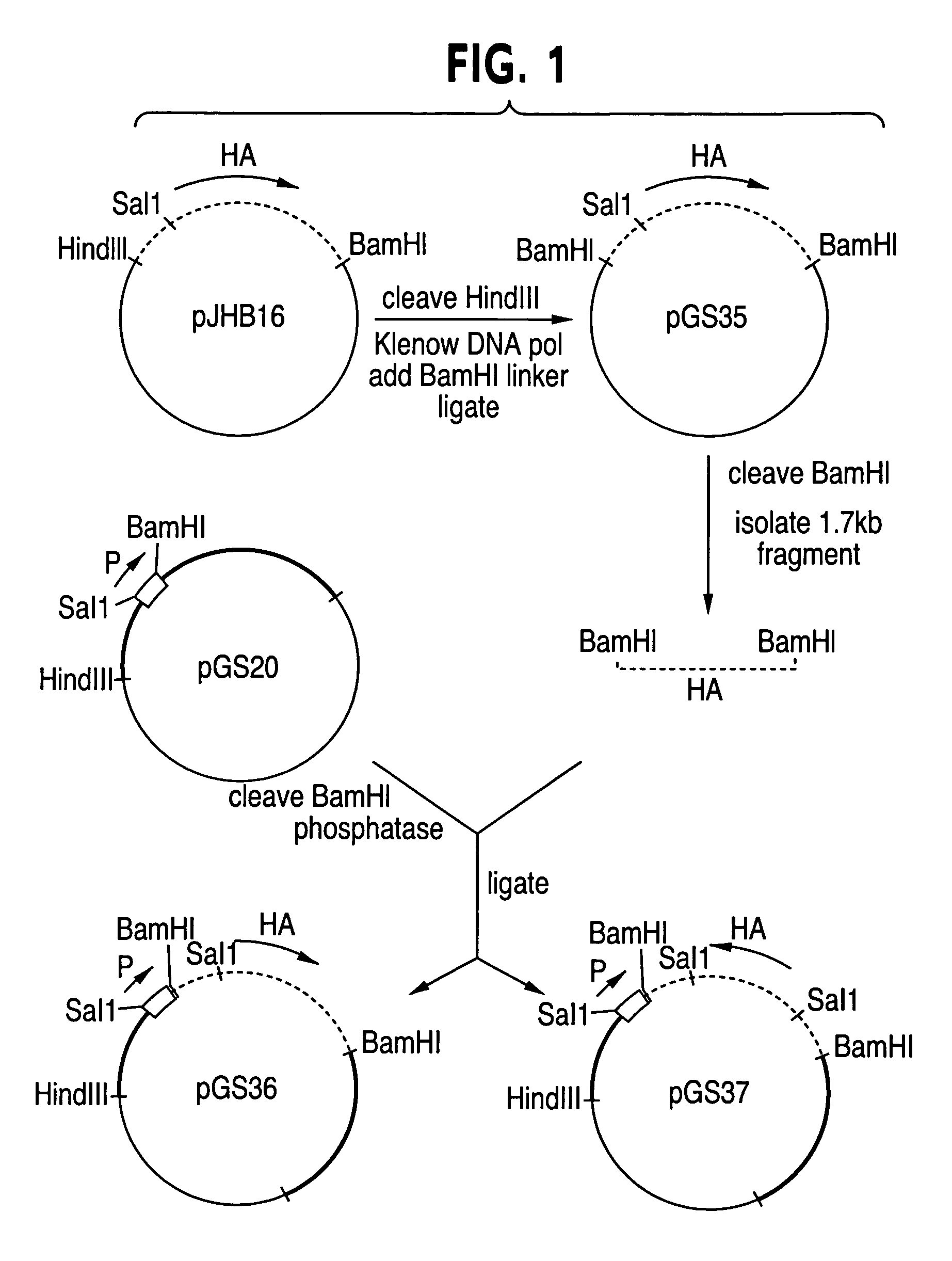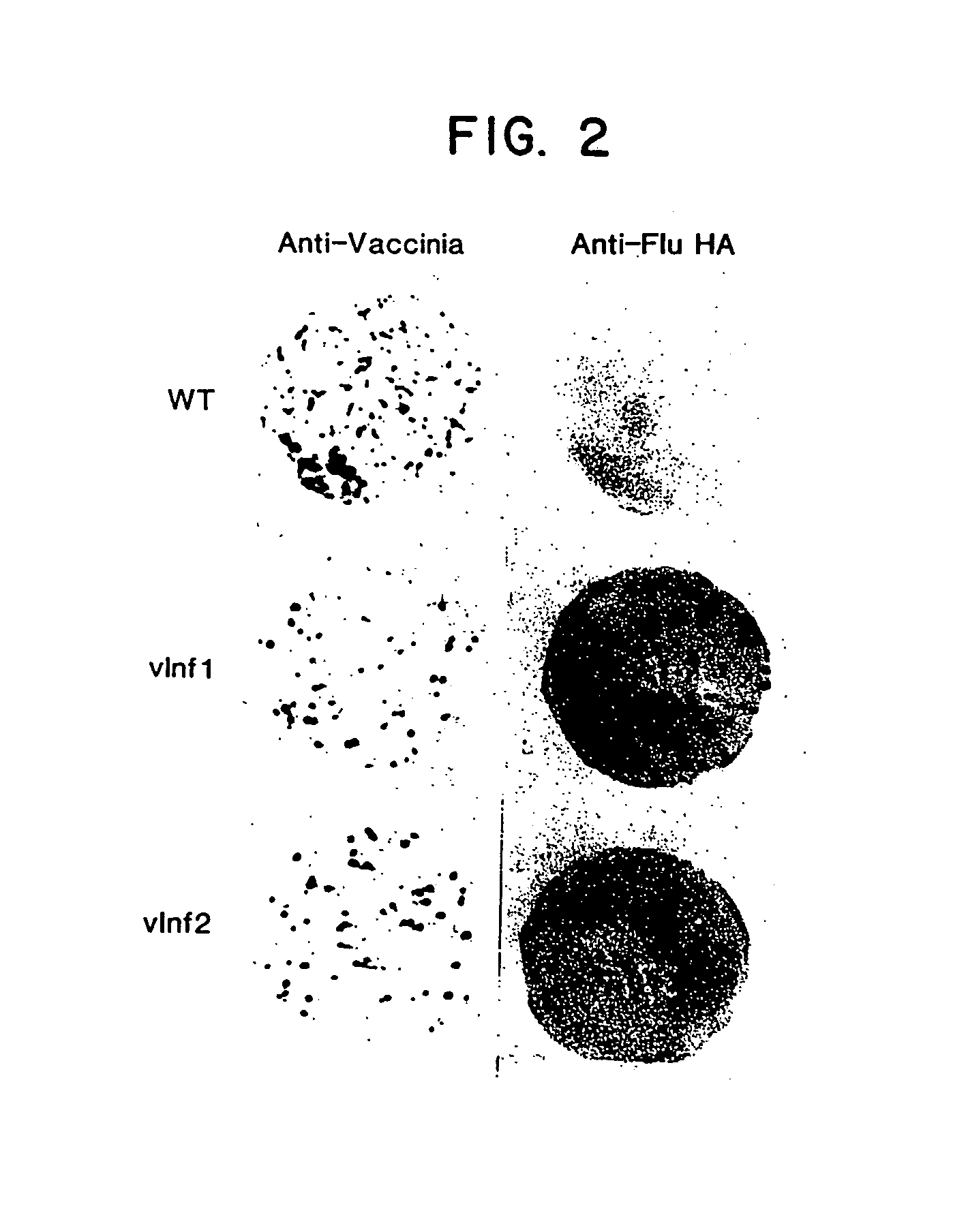Recombinant poxviruses having foreign DNA expressed under the control of poxvirus regulatory sequences
a technology of poxvirus and regulatory sequence, which is applied in the direction of antibody medical ingredients, peptide sources, transferases, etc., can solve the problems of severe limitations on the amount of dna and suffer loss of infectivity
- Summary
- Abstract
- Description
- Claims
- Application Information
AI Technical Summary
Benefits of technology
Problems solved by technology
Method used
Image
Examples
example 1
[0037]Construction of plasmids pGS20 and pGS21 containing promoter from the 7.5K polypeptide gene (7.5K gene) of vaccinia virus, restriction endonuclease sites for insertion of foreign protein coding sequences, and an interrupted vaccinia virus thymidine kinase gene as flanking DNA.
[0038](a) Isolation of 7,5K promoter DNA. A DNA fragment of approximately 275 bp that precedes and includes the RNA start site of an early vaccinia virus gene coding for a polypeptide known as 7.5K was obtained from a plasmid pAG4 [Yenkatesan et al., Cell 125:805–813 (1981)]. 70 μg of pAG4 was digested to completion with 100 units of restriction endonucleases HindlI and RSaI (New England Biolabs) in 50 mM NaCl, 10 mM Tris-HCl (pH 7.4), 10 mM MgSO4, and 1 mM dithiothreitol (DTT) (hereafter cell media salt restriction buffer) for 2 hr at 37° C. Resulting DNA fragments were separated by electrophoresis for 1 hr at 200 volts through a 1.5% agarose gel containing 40 mM Tris-Acatate (TriS-AC) (pH 8.0), 20 mM so...
example 2
[0043]Construction of plasmids pMM3 and pMM4 that contain the promoter of the vaccinia virus thymidine kinase gene, restriction endonuclease sites for insertion of foreign protein coding sequences, and flanking DNA including part of the thymidine kinase gene.
[0044](a) Construction of pMM1. The recent mapping and sequencing of the vaccinia virus thymidine kinase (TK) gene (Weir et al., 1982; Weir and Moss, submitted for publication) allowed us to develop a strategy for isolating the TK promoter with its transcriptional initiation site but devoid of its translational start site. Inspection of the sequence showed a GTC between the transcriptional and translational start sites. If this sequence were ligated to GAC, a sequence GTCGAC recognized by several restriction enzymes would be created. This was achieved in the following manner. 25 μg of a plasmid derived from pUC9 by insertion of the vaccinia HindIII J fragment was cleaved with 50 units of ClaI (Boehringer Manheim) for 2 hr at 37°...
example 3
[0048]Formation of vaccinia virus recombinants that express the prokaryotic chloramphenicol acetyltransferase (CAT) gene.
[0049](a) insertion of the CAT gene into pGS21. A 770 bp DNA fragment containing the CAT gene was isolated from pBR328 by cleavage of pBR328 DNA with restriction endonuclease TaqI followed by agarose gel electrophoresis, electroblotting onto DEAE-cellulose, elution and recovery of DNA by ethanol precipitation and centrifugation. This 770 bp DNA fragment was inserted into plasmid pUC7 as follows. pUC7 DNA was cleaved with restriction enzyme AccI, the 5′ terminal phosphates were removed with calf intestinal alkaline phosphatase and the DNA was recovered after phenol:chloroform extraction by ethanol precipitation, 0.5 μg of linearized dephosphorylated plasmid DNA was ligated with 0.2 μg of the 770 bp fragment under standard conditions described above. Ligated DNA was then used to transform E. coli strain JM103 and white bacterial colonies that grew on 1.5% bacto-agar...
PUM
| Property | Measurement | Unit |
|---|---|---|
| surface area | aaaaa | aaaaa |
| diameter | aaaaa | aaaaa |
| pH | aaaaa | aaaaa |
Abstract
Description
Claims
Application Information
 Login to View More
Login to View More - R&D
- Intellectual Property
- Life Sciences
- Materials
- Tech Scout
- Unparalleled Data Quality
- Higher Quality Content
- 60% Fewer Hallucinations
Browse by: Latest US Patents, China's latest patents, Technical Efficacy Thesaurus, Application Domain, Technology Topic, Popular Technical Reports.
© 2025 PatSnap. All rights reserved.Legal|Privacy policy|Modern Slavery Act Transparency Statement|Sitemap|About US| Contact US: help@patsnap.com



